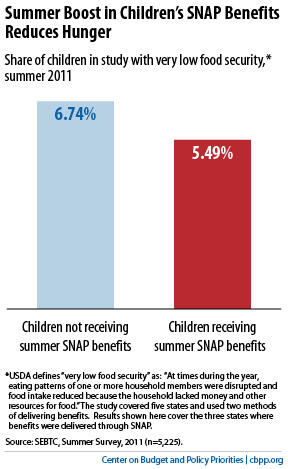off the charts
POLICY INSIGHT
BEYOND THE NUMBERS
BEYOND THE NUMBERS
More Evidence That Boosting SNAP Reduces Hunger
Receive the latest news and reports from the Center
As policymakers pursuing deficit reduction debate big cuts to federal programs — possibly including the Supplemental Nutrition Assistance Program (SNAP, formerly called food stamps) — a new study highlights SNAP’s powerful anti-hunger impact. It’s just the latest evidence showing why we should strengthen SNAP, not weaken it.

As part of one study, households with students who receive free or reduced-price school meals got an EBT (electronic benefits transfer) card containing $60 in SNAP benefits — about the federal cost of providing the missed meals — each month that school was not in session.
Those SNAP benefits cut the share of children who had to skip meals or otherwise eat less because they lacked money (what USDA calls “very low food security”) by nearly one-fifth, from 6.7 percent to 5.5 percent (see graph).
The share of children whose families had trouble affording sufficient food fell by nearly a fifth as well, from 37.6 percent to 31.0 percent.
Children’s nutritional intake also improved modestly. Children receiving SNAP benefits ate more fruits, vegetables, and whole grains.
The fact that boosting food assistance helps low-income households get adequate food shouldn’t surprise anyone. Other research shows that the 2009 Recovery Act’s temporary boost in SNAP benefits enabled more low-income households to afford sufficient food.
Addressing our long-term budget challenges is essential, but it must not come at the expense of critical nutrition assistance.